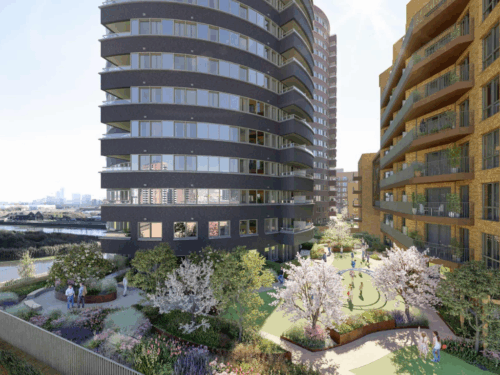
Can Ground Source Heat Pumps Cool Buildings Too?
With another UK heatwave forecast, overheating in high-rise, high-density developments is a growing concern. At Power On, we’re encouraging developers to consider networked ground source heat pumps (NGSHPs) — not just for low-carbon heating and hot water, but for their effective and efficient cooling capabilities too.
Heating and Cooling from One System
Networked ground source heat pumps (NGSHPs) extract naturally stored thermal energy from the ground and deliver it to individual heat pump units in each dwelling. While many are aware of their heating potential, NGSHPs can also provide cooling – making them a versatile and future-ready choice for residential buildings.
How Passive Cooling Works
In winter, NGSHPs deliver heat because the ambient ground temperature is warmer than the air temperature and therefore can provide warmth when passed through a heat pump. In summer, the ambient ground temperature is cooler than the temperature in the building — enabling the system to switch to passive cooling mode. This simply bypasses the heat pump, circulating cool air from the ground through the property – using very little energy. All that’s required is a small circulation pump and fan, making it a low-cost, low-impact alternative to air conditioning.
Importantly, any waste heat extracted from the building during summer can be transferred back into the network — improving the system’s efficiency during the winter.
David Broom, New Build Partnerships Director at Kensa (our heat pump partner) says:
“Passive cooling is a highly effective feature that’s entirely unique to ground source heat pumps. It provides comfort in the summer, uses very little energy, and does so without a bulky outdoor air conditioning unit.”
For projects that need more cooling power
Where more cooling is needed, NGSHPs can also be configured for active cooling, operating like a refrigerator to remove heat from the building and releasing it into the ground — still far more efficient than traditional conditioning.
Supporting Regulations and Reducing Carbon
Networked ground source heat pumps (NGSHPs) are not only energy-efficient — they’re also aligned with key UK building regulations and future standards.
- Future Homes Standard: NGSHPs support compliance by delivering a 75–80% reduction in carbon emissions compared to traditional systems like gas boilers.
- Part O of the Building Regulations: By providing built-in cooling options, they help developers meet new requirements to limit overheating in residential buildings.
Because NGSHPs transfer heat rather than generate it by combustion, they avoid introducing excess heat into buildings — a major benefit in high-rise environments where managing internal temperatures is already a challenge.
Neil Fitzsimons, Managing Director at Power On, concludes:
“Networked ground source heat pumps are a low-carbon, low-cost innovation, ideal for high-rise and high-density developments. Their cooling capabilities are almost a by-product of the heating and hot water solution, making them a win-win option for the developer and the homeowner alike.”
Future-Proof Your Development
NGSHPs are an ideal low-carbon, low-cost solution for high-rise and high-density projects — with the added benefit of integrated cooling.
Speak to our team to find out how we can help your development meet building regulations, reduce carbon, and stay cool through the summer.
Further news at Power On...
- News

Ready for Ofgem? Heat Network Compliance in high-rises
From January 2026, OFGEM will regulate heat networks across the UK, introducing new standards for efficiency, pricing and consumer protection. This article explains what the changes mean for high-rise developments and how developers can prepare with future-proof, low-carbon heating solutions.
- News

How to cool high-rise buildings
With hotter summers and tightening regulations, overheating is a growing challenge. Ground source heat pumps provide a sustainable, low-cost cooling solution.
- News

Low-carbon district heating and multi-utility network for Rivermark development
We’ve been appointed to design, build and adopt the complete multi-utility and low-carbon district heating network for Rivermark — a major new riverside development by Taylor Wimpey in Poplar, East London.
